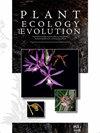Reassessment of morphological species delimitations in the Cyperus margaritaceus-niveus complex using morphometrics
IF 1.1
4区 生物学
Q3 PLANT SCIENCES
引用次数: 0
Abstract
Background and aims – The Cyperus margaritaceus-niveus complex is a group of ten tropical species from sub-Saharan Africa and Madagascar: C. karlschumannii, C. kibweanus, C. ledermannii, C. margaritaceus, C. niveus, C. nduru, C. obtusiflorus, C. somaliensis, C. sphaerocephalus, and C. tisserantii. They are characterised by a capitate head of white-yellow spikelets and modified culm bases and recent molecular analysis puts them in a distinct clade. The group lacks a modern taxonomic revision, and the taxa described in the Flora treatments of the past 50 years differ considerably in their circumscription. In this study, morphometric analyses are used to test species limits to establish more stable morphological delimitations of the taxa. Material and methods – An examination of 15 morphological characters on 489 herbarium specimens was carried out and the data was analysed using Principal Component Analysis (PCA), Linear Discriminant Analysis (LDA) with cross-validation, and Classification and Regression Tree (CART) analysis. Cyperus kibweanus was not further considered due to lack of material. Key results – Both PCA and LDA showed varying degrees of overlap in the nine remaining taxa, with no single group clearly separating in multivariate space. However, cross-validation clearly showed C. margaritaceus as a distinct entity despite its overwhelming presence in the PCA. Both LDA and CART failed to separate C. niveus as a distinct group as its specimens were dispersed among the other groups. Differing results were obtained for other taxa depending on the type of analysis. Cyperus margaritaceus, C. nduru, and C. sphaerocephalus were divided into two groups by CART but re-examination of the specimens does not definitively support the idea that these infraspecific groups represent separate taxa. Conclusions – The results show that eight morphospecies are recognised by LDA and six morphospecies by CART. Characters used to separate the taxa in Flora treatments scored high loadings in the analysis showing their high taxonomic utility value. The methods used can be applied to resolving other complexes in the Cyperaceae.用形态计量学重新评价玛格丽塔塞-尼维乌斯复合体的形态种划分
背景和目的-Cyperus margaritaceus niveus复合体由来自撒哈拉以南非洲和马达加斯加的十个热带物种组成:C.karlschumanii、C.kibweanus、C.ledermannii、C.margaritacheus、C.niveus、C.nduru、C.obtusiflorus、C.somaliensis、C.sphaerochalus和C.tisserantii。它们的特征是头状头状的白黄色小穗和改良的秆基部,最近的分子分析将它们置于一个独特的分支中。该类群缺乏现代分类学修订,过去50年的植物志处理中描述的分类群在其范围上有很大差异。在这项研究中,形态计量分析用于测试物种界限,以建立更稳定的分类群形态界限。材料和方法——对489个植物标本的15个形态特征进行了检查,并使用主成分分析(PCA)、带交叉验证的线性判别分析(LDA)和分类回归树(CART)分析对数据进行了分析。由于缺乏材料,没有进一步考虑柏树。关键结果——主成分分析和LDA在剩下的九个分类群中都显示出不同程度的重叠,在多变量空间中没有单独的组明显分离。然而,交叉验证清楚地表明,尽管在主成分分析中有压倒性的存在,但玛格丽塔菌是一个独特的实体。LDA和CART都未能将C.niveus作为一个独特的群体进行分离,因为其标本分散在其他群体中。根据分析类型的不同,其他分类群获得了不同的结果。通过CART将玛格丽塔香柏、nduru香柏和球形头香柏分为两组,但对标本的重新检查并不能完全支持这些种下类群代表独立类群的观点。结论-结果表明,LDA识别了8种形态物种,CART识别了6种形态物种。在植物区系处理中用于分离分类群的性状在分析中得分较高,显示出其较高的分类实用价值。所用的方法可应用于莎草科植物中其他配合物的拆分。
本文章由计算机程序翻译,如有差异,请以英文原文为准。
求助全文
约1分钟内获得全文
求助全文
来源期刊

Plant Ecology and Evolution
PLANT SCIENCES-
CiteScore
2.20
自引率
9.10%
发文量
27
审稿时长
>12 weeks
期刊介绍:
Plant Ecology and Evolution is an international peer-reviewed journal devoted to ecology, phylogenetics and systematics of all ‘plant’ groups in the traditional sense (including algae, cyanobacteria, fungi, myxomycetes), also covering related fields.
The journal is published by Meise Botanic Garden and the Royal Botanical Society of Belgium.
 求助内容:
求助内容: 应助结果提醒方式:
应助结果提醒方式:


